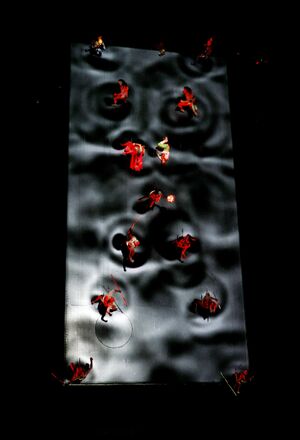In the early 21st century, stage automation made it possible to control large scenic elements in complex ways, and integrate their movement into elaborate performances with performers, light, video and sound.
From the late 19th century, stage machinery began to change from being moved by muscle-power to being powered by hydraulics and electric motors (A.06). Large stage lifts and revolves by their nature need to be powered, but flying systems have in many cases stayed with the older technology of manually operated counterweights. However, by the early years of the 21st century, powered flybars were increasingly common, especially in new, or larger, well-funded theatres. The adoption of powered systems has been driven both by an artistic demand for larger, heavier scenery, as well as safety concerns.
As soon as powered stage mechanics began to be used, the question arose of how to control them. Permanent installations in theatres, such as flying, stage lifts, trucks and revolves, came with their own, bespoke controls. The same was true of the temporary stage machinery built for specific shows. The ‘mega-musicals’ of the 1980s, such as Les Misèrables and Miss Saigon, had substantial mechanised scenic elements, powered and controlled by systems built specifically for the show. From the early 1990s, however, companies such as Stage Technologies (now part of TAIT, Q30635) began to develop re-usable components such as winches, motors and controllers. The control system became more than a series of manual controllers; adopting principles established in lighting control, the new breed of ‘automation controllers’ could be pre-programmed with cues, so that multiple scenic movements could work in perfect synchronisation. They differed from theatre lighting consoles by offering immediate manual override, and a large ‘emergency stop’ button. The powered stage was now stage automation.
Through the first two decades of the 20th century, the systems continued to evolve. Stage automation systems can now integrate with other technical systems, so that lighting, sound and video can be perfectly synchronised. Motion control systems mean the automation controller can know exactly where the scenic element is in space, correcting for any errors to give very precise positioning. This allows, for example, two pieces of scenery to move together and meet exactly, or a video image or a moving light to precisely track the moving scenery. Large shows such as KÀ, the 2005 production by Cirque Du Soleil, directed by Robert Lepage (Q436), make extensive use of these types of technologies, and give a sense of what can be achieved.
KÀ is a story about the journey of self-discovery for twins who are separated and fight to find their way back to each other. The KÀ Theater inside the MGM Grand, Las Vegas, Nevada, has a capacity of 1950 people. Its unique floating stages help immerse the audience in the story combined with complex automation, pyrotechnics, puppetry, and multimedia projections. KÀ lacks a conventional stage with a permanent floor; instead, two giant moving platforms and five smaller lifts and platforms appear to float in a bottomless space. A narrow boardwalk separates the audience from a deep abyss where the stage floor would normally be. From the stage level of the boardwalk up to the grid is 30m, and the pit drops 16m below. The width and depth of the performance area are each 37m. The performance space is reconfigured with each scene change by the movements of the show’s lifts and platforms.
The largest moveable platform employed in the show, the Sand Cliff Deck, measures 7.6 x 15.2 x 1.8m and weighs 50 tons. A vertical gantry crane supports and controls the Sand Cliff Deck, lifting the platform up and down 22m, rotating it 360 degrees and tilting it from flat to 100 degrees. This is attached to four 23m long hydraulic cylinders that run along two support columns. The Sand Cliff Deck has circular elevators to bring performers in and out, 80 ‘rod actuators’ that sprout from the floor surface to enable performers to climb it when it is tilted vertically, and video tiles that allow computer-generated images to appear on the floor. The second largest platform, the Tatami Deck, is a cantilevered 9.1 x 9.1m platform located upstage of the Sand Cliff Deck, and slides in and out like a drawer to provide a horizontal stage and carry massive set pieces such as the Wheel of Death. These two decks can appear alone or together or simply disappear from view; they can move in front of, behind, above or below each other.
An object on stage can move up and down, from side to side, or forwards and backwards: movement on the three axes, X, Y and Z. It can also rotate about these three axes – it has six ‘degrees of freedom’. While not every object on stage – every prop, every piece of scenery, every person – can move or turn in any direction, stage automation has brought us closer to this possibility than ever before.

